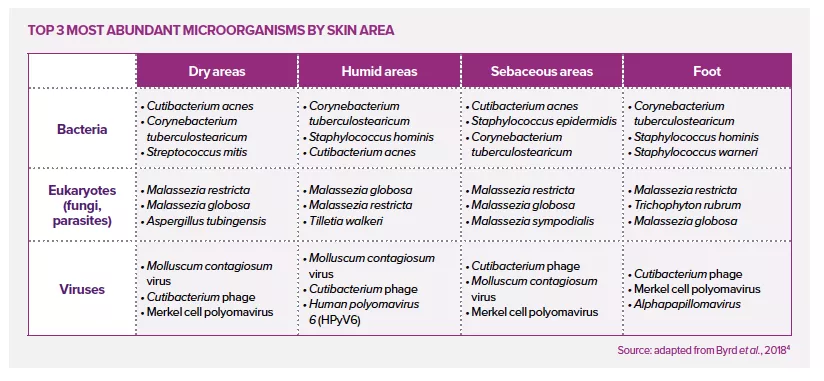A unique set of skin microbiota for each individual
The fourth most populated microbial niche in the human body,2 the skin is home to a complex community of microorganisms.2 Bacteria, fungi, parasites and viruses live together on the skin in a unique balance specific to each individual, to the point where some investigators speak of an individual microbial fingerprint.5
Sources
This article is based on scientific information
Sections

Staphylococcus epidermidis
About this article
Each individual is not characterized by one but by multiple skin microbiota. In fact, the skin microbiota varies “horizontally”, according to skin area (face, armpits, etc.), but also “vertically”, according to the layers that make up the skin epithelium.
BACTERIA, FUNGI, VIRUSES AND PARASITES
Although easily accessible, the skin microbiota remains poorly understood. Its density is believed to be low compared to that of the large intestine, instead resembling that of the small intestine, i.e. around 1011 bacteria.1 It is the fourth largest microbial niche in the body in terms of the number of microorganisms, just after the digestive tract, the oral cavity and the vagina.2
It hosts several bacterial phyla (Actinobacteria, Firmicutes, Proteobacteria and Bacteroidetes), archaea, and fungal species mainly from the genus Malassezia.2,3 Among the bacterial species identified are included Cutibacterium acnes and Staphylococcus epidermidis, although the strains present differ depending on the individual, the state of their skin (healthy or otherwise) and the sampling site.3,6
Lastly, although not well described,2 numerous viruses (papillomavirus, adenovirus, etc.) have been identified on the skin of healthy individuals, as well as phages that target C. acnes and S. epidermidis, suggesting the existence of a complex virome. Parasites (such as Demodex mites, etc.), few in number, are even more scantly described.3
“HORIZONTAL” VARIATION ACCORDING TO SKIN AREA
The skin is not a homogeneous habitat. The surface of the skin is acidic, salty and aerobic, whereas the invaginations of the hair follicles offer a lipid-rich and anaerobic environment6.
Three major niches are generally identified based on properties such as pH, temperature, humidity, perspiration levels and lipid content:1,3,4
- sebaceous areas (face, chest, back) that secrete lipid-rich sebum;
- dry areas (forearms, palm of the hand);
- humid areas (armpits, elbow crease, nostril, back of the knee and groin), where numerous sweat glands participate in thermoregulation (sweat), acidify the skin and secrete antibacterial peptides.
Some authors distinguish a fourth area in the foot (nails, heel and space between toes)4 (see table).
These areas are separate ecological niches, each with a unique microbial community: the most exposed and dry areas, such as the hands, are the most diverse; the armpit, which is moist and rich in sweat, is dominated by Corynebacterium and Staphylococcus species; while lipid-rich areas, such as the face, display much less diversity (Cutibacterium bacteria, fungi of the genus Malassezia, and Demodex folliculorum mites).3
Microbiota also vary in density from one skin area to another: from 102 bacteria per cm2 on the fingertips or back, to 106 bacteria per cm2 on the forehead or in the armpits.2

“VERTICAL” VARIATION ACCORDING TO SKIN LAYER
For a long time, it was thought that microbial life in the skin was limited to the epidermis, hair follicles, and sebaceous and sweat glands. However, microorganisms also seem to live in the deeper layers of the skin, i.e., the dermis and the underlying adipose tissue.2
On the skin’s surface, the deeper into the stratum corneum the fewer microorganisms are present.1
Then, from the surface to the subcutaneous regions, the microbiota changes and gradually loses its individual characteristics.4,5
In the dermis and subcutaneous adipose tissues, there seems to be more Proteobacteria while there are less Actinobacteria and Firmicutes than in the epidermis.2







